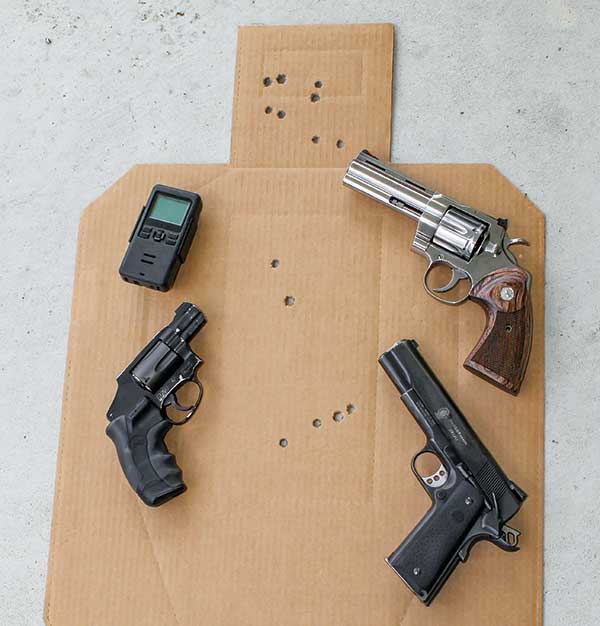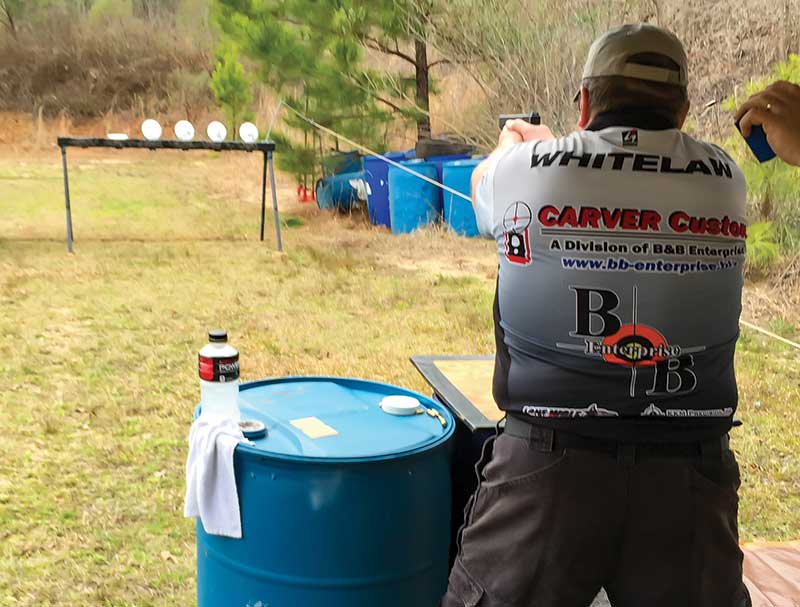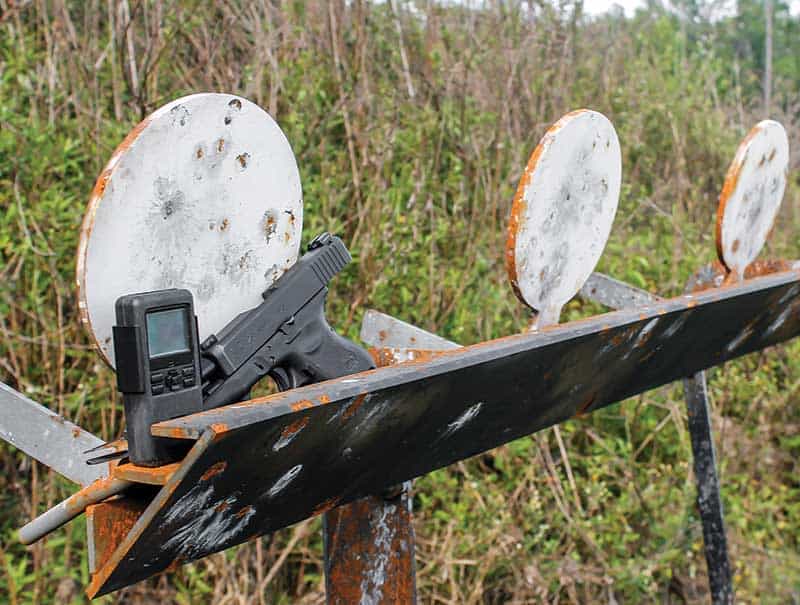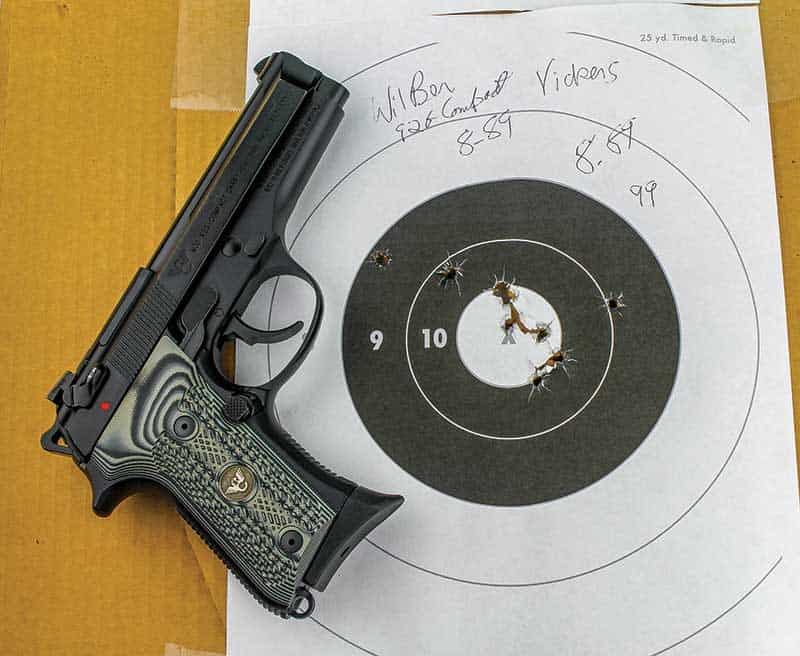Improve Your Defensive Skills
Learn from defensive handgun drills
Decades of teaching has shown the value of proven drills for self-assessment, especially when comparative standards are applied. When students ask me how they should practice, my standard answer is, “If you’re serious, you’ll never practice again. Instead, you’ll train. Make every shot have a purpose, and diagnose and correct any shortcoming in accuracy and speed.”
The purpose is diagnosis. Time-proven drills, and standards to which we can compare our performance, are key elements. With this in mind, let’s look at a few established drills.
The Wizard
Developed by the combat handgun master Ken Hackathorn, this is a simple concealed carry test, so a cover garment is required. Use your carry gun and holster, and your carry ammo. Yeah, those premium rounds are expensive, but you’ll only need five, and an electronic gunshot timer. The target is an IPSC or IDPA cardboard silhouette, with a 4″ circle drawn in center head.
There are four strings of fire, each lasting 2.5 seconds. Start loaded, holstered and concealed, hand well away from the gun. From 3 yards, on the signal draw and fire one shot to the center head circle, dominant-hand only. After this, you can go two-handed throughout. Draw to a head shot from 5 yards. Do it again from 7 yards. From 10 yards, draw and fire two to the center zone of the body of the target. A missed head shot, anything over time or more than two points down is a disqualification.
Goal: Comprehensive test of concealed carry skills
Focus Drill
Some call it “dot drills” and in its most sophisticated form, it can be done as the Dot Torture drill, developed by a great master we lost all too soon, Todd Louis Green. You can find details and download the Dot Torture target online.
I use a simpler version. At 3 to 5 yards, start from low ready, pistol decocked or safety on. At the command, aim at one tiny spot and fire 15 to 18 shots. There’s no time limit — it’s an accuracy drill. It’s useful for anyone from novice to grandmaster. If you want to make it a little more challenging, use the first hole as the target for subsequent shots. Why such close range? It factors out things like wind or crappy ammo that doesn’t group well, eliminating such excuses and forcing you to focus on errors like “milking” the gun or jerking the trigger.
The idea is to get all hits in one ragged hole. When I was serious about competition and shot on the “pro tour,” I started and finished every training session with a Focus Drill.
Goal: Develop neural pathways that hardwire everything from brain to trigger finger what it feels like to make a perfect shot.
Plate Rack Drills
It’s easy to apply marksmanship fundamentals such as front sight focus on a piece of paper or cardboard. Not so much on a target that reacts to the shot. The Necco wafer shattered or balloon broken by a plinker’s .22 slug, the ringing steel or knockdown Pepper Poppers of Steel Challenge and USPSA competition or blowing a bowling pin off a table all involve reaction targets. The animal in the game field, and particularly the homicidal human trying to kill us, is the ultimate reaction target. Our subconscious will be screaming, “Front sight? Hell, we gotta see if that thing we’re shooting at falls over!” We need to condition ourselves to focus on the task to achieve the goal. I’ve found the most useful, versatile and time-effective reaction target is the Plate Rack.
The rack of six 8″-diameter steel disks was created by Ray Chapman for the first Bianchi Cup. The Bianchi Plates were pass/fail: You had six shots only for six plates, no mulligans, and you started with handgun holstered (no concealment required) and hands shoulder high. At 10 yards at the Bianchi Cup, your time allowed is 6 seconds, 7 seconds at 15 yards, 8 seconds at 20 paces and 9 seconds from 25 yards. You have 10 points possible per shot, which means every plate not knocked down with one shot sucks 10 victory-killing points away from your score.
You shoot from low ready and will need an electronic timer. For purposes of this article, I looked up my plate scores at my last GSSF match, earning plate scores of 14.86 (average 3.715 seconds for six plates) on the first and 18.49 (4.623 seconds) on the second, which showed me I needed to work on consistency. I took the same G26 to my own Action Target plate rack at the same distance for this article, and ran 17.22 seconds (average 4.305 seconds), which told me I needed to work on consistency. I checked the time of overall match winner Andrea Boone, the young Supergirl of GSSF. In the GLOCK Girls event, she had nailed four sets of plates in 10.14 seconds, an average of 2.535 seconds. This told me I needed to learn to “shoot like a girl.”
Goal: Teach ourselves “One shot, one hit, move on smoothly and quickly,” and “Once the target is identified, focus on the front sight.”
The 5-Yard Roundup
Ace instructor Tom Givens introduced me to this very useful drill created by retired combat Marine officer Justin Dyal, now a rising star in stateside firearms training. Your carry gun and holster are concealed and hands are clear to start. You get 2.5 seconds for each of four runs requiring only 10 rounds total. Please use your carry ammo. Your target is the unforgiving heart-size, black bull’s-eye of an NRA B-8 timed and rapid-fire target, all at 5 yards distance.
Draw and fire one shot, two hands allowed. From low ready, fire four shots in the same 2.5 seconds. Next, fire three shots from low ready using your dominant hand only. Finally, fire two shots from low ready using your non-dominant hand only.
Goal: Hone skills for the first critical moments of a defensive encounter before reloading or seeking cover even become options, while achieving centered, fight-ending hits.
Vickers 10-10-10
Larry Vickers, master instructor and Delta Force alumnus, also chose the B-8 with its roughly heart-size black bull for the drill bearing his name consisting of 10 shots, 10 seconds, 10 yards. On the Beginner’s Slope, start from low ready and give yourself full credit for anything in the black circle. Advanced? Do it from concealment starting with hands clear and use the unforgivingly tight scoring rings to determine hit value.
Goal: Develop precision, fight-stopping accuracy and pace of fire.
Qualification Courses
If you ever have to use your gun for defense of self or other innocent parties, you’ll have to deal with the justice system, both criminal and civil. In either arena you’re very likely to face the question, “What made you think you were competent to walk around in public with a loaded gun like a trained and qualified police officer?” It would be awfully helpful if you could answer, “The record shows I’ve qualified to a prevailing police standard.” Google will get you to police qualification courses approved by your state. Shoot such quals (video won’t hurt at all!) and keep records of them.
In the “civilian” world, I never found a better “qual course” than the original 90-shot IDPA Classifier; it encompassed strong hand and weak-hand only, moving forward and back while shooting and firing from behind barricades from as far as 20 yards. Requiring three target frames and two types of barricades per run, not to mention almost two boxes of training ammo, some found it cumbersome.
A few years ago Bill Wilson came up with his 5X5 Classifier; it’s a lot simpler and you can find it online. This version requires only one target, no props and 25 rounds.
Goal: Qualify to a high standard widely recognized for law-abiding armed citizens.
I’m out of space, but many more drills like this can be found on the Net. They hold us to a demanding standard and motivate us to be better at the lifesaving skills we need when we keep and carry defensive firearms.
For more info:
MassadAyoobGroup.com, Pistol-Training.com/drills/dot-torture, IDPA.com/wp-content/uploads/2018/09/IDPA_5x5_Classifier.pdf

Get More Personal Defense Tips!
Sign up for the Personal Defense newsletter here:











